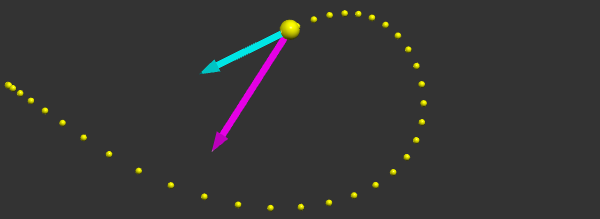Position, Velocity, Acceleration
List of Links
This page is all about learning the relationships between position, velocity and acceleration.
- Written Materials
- Video: The Position Vector
- Video: The Velocity Vector
- The Acceleration Vector
- Video: Acceleration Along a Straight Line
- Video: Acceleration When Traveling in a Circle
- Video: Acceleration on a Curvy Path
- 1D Interactive Web Simulation
- Video: Acceleration Along Curved Paths
- 2D Interactive Web Simulation
Written Materials
This document covers fundamental definitions of position, velocity, and acceleration that will be used throughout the course.
covers fundamental definitions of position, velocity, and acceleration that will be used throughout the course.
Video: The Position Vector
The position vector \( \vec r(t) \) is used to express the location in space. In dynamics, that position vector will change in time. By defining that position vector, we can start describing that motion.
Video: The Velocity Vector
Velocity is a vector that is defined as the derivative of the position vector: \( \vec v (t_0) = \left. \frac{d \vec r}{dt} \right|_{t_0} \). But what is the derivative of a vector? Well, we can use the definition:
$$ \vec v (t_0) = \left. \frac{d \vec r}{dt} \right|_{t_0} = \lim_{\Delta t \rightarrow 0} \frac{\vec r(t_0 + \Delta t) \, – \, \vec r(t_0)}{\Delta t}.$$
The video below shows how to use the definition above to construct the velocity vector.
If you’re interested there is a similar video that lays out how to define the velocity vector when the object moves along a straight line.
The Acceleration Vector
Acceleration is a vector defined as the derivative of velocity.
$$ \vec a (t_0) = \left. \frac{d \vec v}{dt} \right|_{t_0} = \lim_{\Delta t \rightarrow 0} \frac{\vec v(t_0 + \Delta t) \, – \, \vec v(t_0)}{\Delta t}.$$
It turns out that the nature of the acceleration vector is a bit different on straight and curvy paths, so we will consider both separately.
Video: Acceleration Along a Straight Line
We start with the simpler case. In the video, we construct the acceleration vector in the case that an object is moving back and forth along a straight line.
Video: Acceleration when Traveling in a Circle
Now we begin to ask what happens to acceleration when the path gets curvy. We start with the simplest case: moving at constant speed around a perfect circle. The result is centripetal acceleration.
Video: Acceleration on a Curvy Path
Now we will consider the case of a general curvy path and not assume that the object is traveling with constant speed. Doing so gives us acceleration with both tangential and perpendicular components.
An Interactive Web Simulation (Spewton1D)
Click here to experiment with an interactive web simulation that illustrates the concepts above. [It is recommended that you use a desktop or laptop computer to run this simulation.]

Video: Acceleration Along Curved Paths
When an object moves along a curved path, it experiences a centripetal acceleration perpendicular to the path. The video shows where this acceleration comes from.
Elsewhere, I show you how to quantify this acceleration.
Spewton, A 2D Interactive Web Simulation
Click here to experiment with a 2D Interactive web simulation that illustrates the concepts above. It is recommended that you use a desktop or laptop computer to run this simulation.
